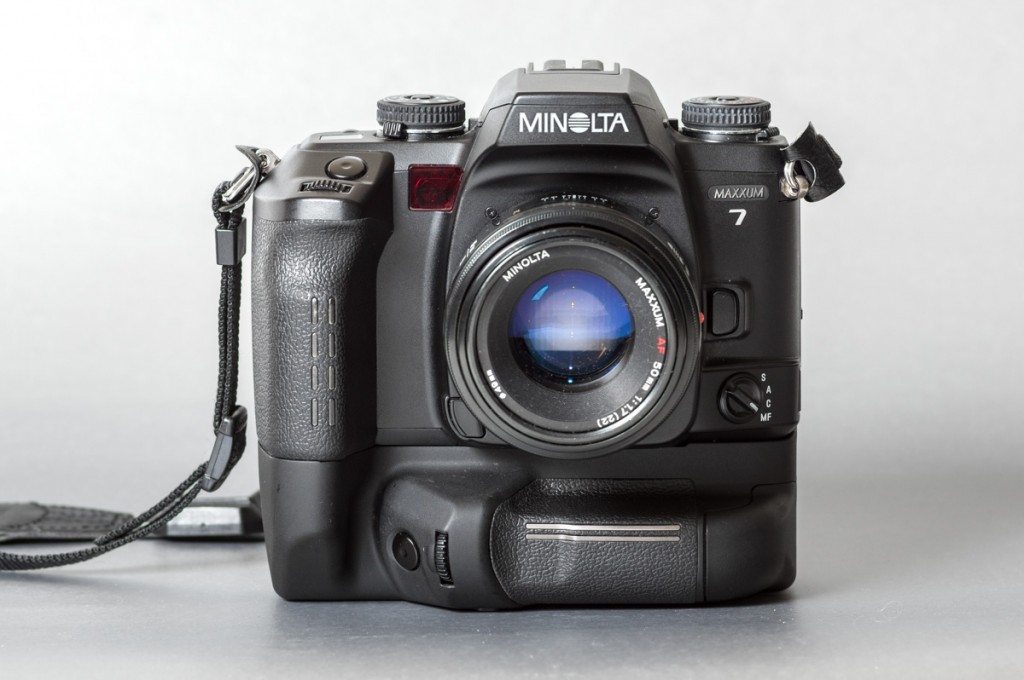Minotla Maxxum 7
I had the opportunity to borrow a Minolta Maxxum 7 recently. What a fantastic camera. It’s now nearly a 20 years old model but many of the controls and features remain familiar today on high end interchangeable lens cameras. Things such as front and back control dials for aperture and shutter settings, an exposure compensation dial and even a flash compensation dial. The stand out feature though has to be the large LCD on the back that provides a myriad of information. It has enough area to display everything you need to know while your shooting. My favourite use of the LCD though has to be the ability to view what the 14 segment honeycomb metering system is measuring. This is performed by pressing the AE-lock button followed by the DISP button. Each segment is then displayed as one of three shades with addition information inside. If the segment is white it references positive EV above +1 and if its black it denotes -1 EV or lower in the middle is grey for values between those two. If the value in a segment exceeds +3 then it will just have a + sign and if it is below -3 it has a – sign. It really looks better and is more intuitive than I can describe so maybe a picture is better.
Now 14 segments may not constitute a full image but it is enough information to evaluate your exposure.
Another great use for that big LCD is for looking at the recorded shot data. Not just what you are currently up to but it retains the history of 11 parameters for up to 7 rolls of film. After I shot my two rolls of film I was able to go back and see what setting I had used for each shot. We take this for granted with digital cameras but its a fantastic feature for use with film. I rarely have the patience to record exposure details manually.
There are many more controls I won’t be going over, there is always a manual for that but a few interesting things are located when you flip down the cover below the LCD and press the custom button. This brings you into the menu for those features that are needed less frequently such as whether to leave the film leader out after the roll rewinds among other things. Its Custom function 25 though that is interesting and unique to this camera, it allows you to set the user preset 3 to one of two purposes. The first being a user present obviously but it can also be changed to STF mode. Despite this menu being in plain language I realize that STF may not be overly descriptive so I will give you a moment to guess what it stand for….times up it stands for Smooth Transition Focus. Okay great but what is that Wallace? you may be asking to which I will say that is worthy of its own blog post at a later date.
I have been using the camera with the battery grip and ergonomically speaking it feels great. Every control has a unique feel and placement such that you can operate the camera completely by feel in the dark with a little practice. Did I mention that the LCD on the back has a nice indigo backlight? I did now. In contrast though there is a tiny little LCD on the top plate that provides shutter and aperture information. This might be okay when working on a tripod in good light but its a little limited. I felt that I needed to say at least one negative thing about the camera, done.
The camera has a fantastic multiple exposure implementation. Unlike many other cameras all you need to do with the Maxxum 7 is set the drive mode to the red multiple exposure setting and that’s it. Each time you press the shutter it takes another exposure without advancing the film. Additionally it keeps a tally and displays how many exposures you’ve done up to 9. You can keep exposing after those 9 but the camera no longer will keep count. You can even turn the camera off and on during a multiple exposure sequence. Of course you don’t want to forget it in that mode or you will end up with some unintended results.
The shutter reaches a fast 1/8000 of a second and it can fire off up to 4 frames per second. I’ve covered some of the highlights of the Maxxum 7 but to sum it up its a feature rich camera with excellent controls that feels fantastic in the hand. I do prefer it with the VC-7 grip which has the added benefit of allow the use of AA batteries instead of expensive lithium ones in the main body. Having also borrowed a Nikon F5 which is a tank of a camera I can say that the Maxxum 7 has more features and is better laid out and easier to use. The F5 though feels like you can use it to hammer nails. I will finish off with some images and mention again that I will be doing a separate post about the Smooth Transition Focus feature. (If I have already posted it when you read this you will find the link here ————–)




























